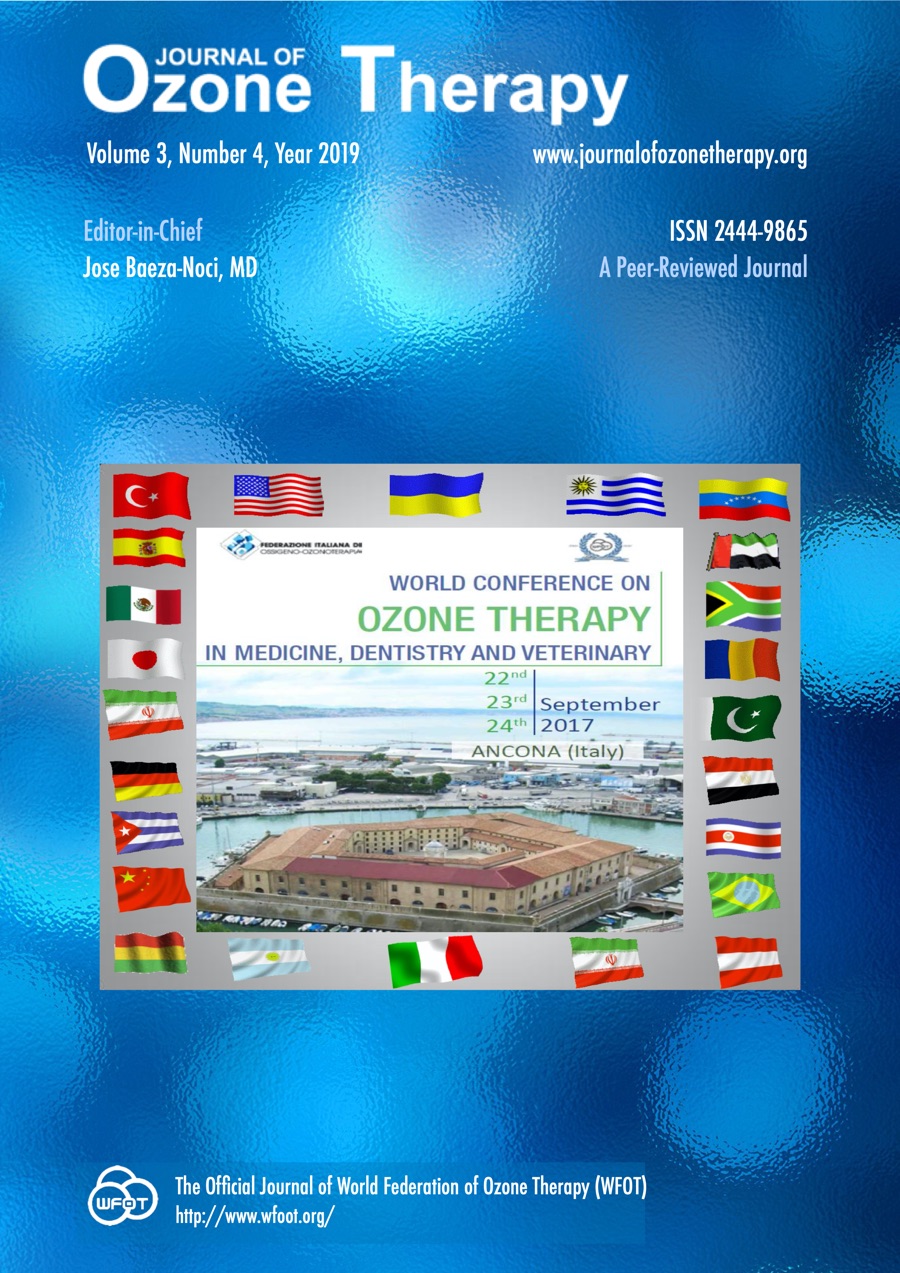Intraperitoneal and local ozone applications in veterinary oncology treatment [abstract]
DOI:
https://doi.org/10.7203/jo3t.3.4.2019.15397Keywords:
intraperitoneal ozone therapy Abstract
Abstract
The elevated incidence of some non treatable, or with low therapeutic results, side effects in certain areas of veterinary medicine such as oncology, orthopaedics, wounds and infections in dogs, cats, and horses is notoriously reported and differentiated in several infirmities. These side effects manifest in symptoms acting as locomotor disability, pain, and in some cases, they result in a great loss of life quality in animals and their owners alike. Therefore, intraperitoneal and local ozone applications have brought relevant results and are now being used as complementary or, in certain cases, only treatment. The goal of this lecture is to show the use as well as the results and techniques used in oncological pathologies treated with intraperitoneal and local ozone applications which did not respond ,or had low therapeutic results, to conventional veterinary treatment. All this demonstrates that Intraperitoneal as well as local ozone applications are powerful tools available to veterinarians in order to promote relief, comfort, or, possibly, cure to animals.
 Downloads
Downloads
 References
References
Schulz S, Haussler U, Mandic R, et al. Treatment with ozone/oxygen-pneumoperitoneum results in complete remission of rabbit squamous cell carcinoma, Int. J. Cancer. 2008;122,2360–2367.
Dunne AA, Mandic R, Ramaswamy A, et al. Lymphogenic metastatic spread of auricular VX2 carcinoma in New Zealand white rabbits. Anticancer Res 2002;22:3273–3279.
Schaefer C, Kim GG, Albers A, Hoermann K, Myers EN, Whiteside TL. Characteristics of CD41CD251 regulatory T cells in the periph- eral circulation of patients with head and neck cancer. Br J Cancer 2005;92:913–920.
Schneider MR, Tang DG, Schirner M, Honn KV. Prostacyclin and its analogues: antimetastatic effects and mechanisms of action. Cancer Metastasis Rev. 1994;13:349–364.
Bhardwaj N. Harnessing the immune system to treat cancer. J Clin Invest. 2007;117:1130–1136
Lin WW, Karin M. A cytokine-mediated link between innate immunity, inflammation, and cancer. J Clin Invest 2007;117:1175–1183.
Schulz S, Rodriguez ZZ, Mutters R, Menendez S, Bette M. Repetitive pneumoperitoneum with ozonized oxygen as a preventive in lethal polymicrobial sepsis in rats. Eur Surg Res. 2003;35:26–34.
van Es RJ, Baselmans AH, Koten JW, Van Dijk JE, Koole R, Den Otter W. Perilesional IL-2 treatment of a VX2 head-and-neck cancer model can induce a systemic anti-tumour activity. Anticancer Res. 2000;20:4163–4170.
Neudecker J, Sauerland S, Neugebauer E, et al. The European Association for Endoscopic Surgery clinical practice guideline on the pneumoperitoneum for laparoscopic surgery. Surg Endosc. 2002;16:1121–1143.
Hicks AM, Riedlinger G, Willingham MC, et al. Transferable anticancer innate immunity in spontaneous regression/complete resistance mice. Proc Natl Acad Sci USA. 2006;103:7753–7758.
Downloads
Published
How to Cite
-
Abstract790
-
PDF433
Issue
Section
License
Journal of Ozone Therapy applies the Creative Commons Attribution-NonCommercial 4.0 International License (CC BY NC 4.0) license to works we publish.
Under this license, authors retain ownership of the copyright for their content, but allow anyone to download, reuse, reprint, modify, distribute and/or copy the content as long as the original authors and source are cited. No permission is required from the authors or the publishers.
You may not use the material for commercial purposes.
Appropriate attribution can be provided by simply citing the original article, provide a link to the license, and indicate if changes were made.
You may do so in any reasonable manner, but not in any way that suggests the licensor endorses you or your use.




